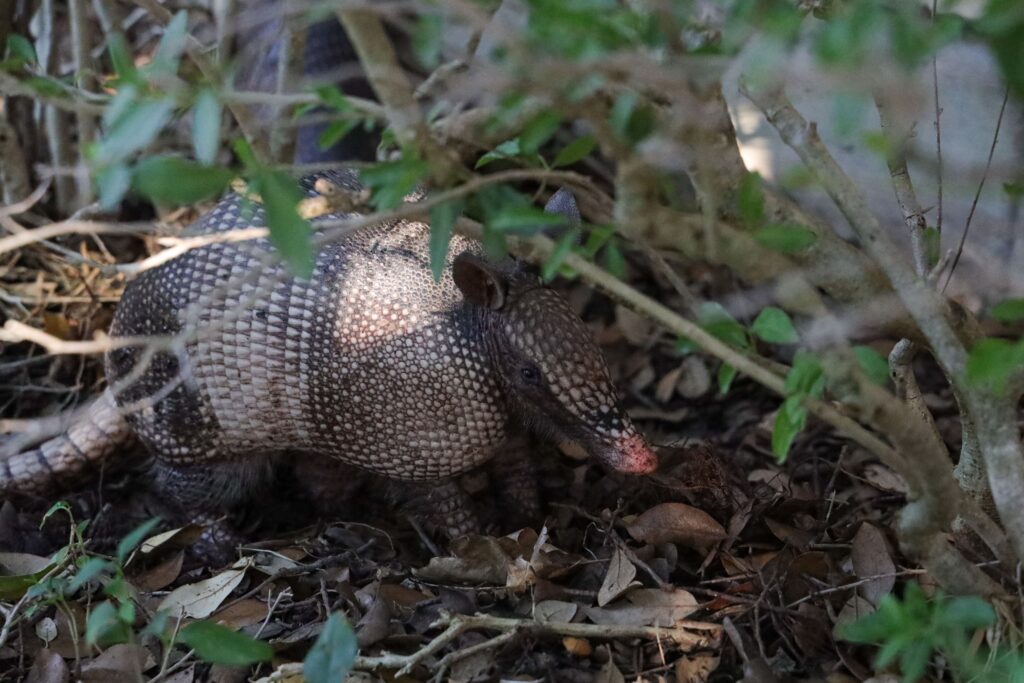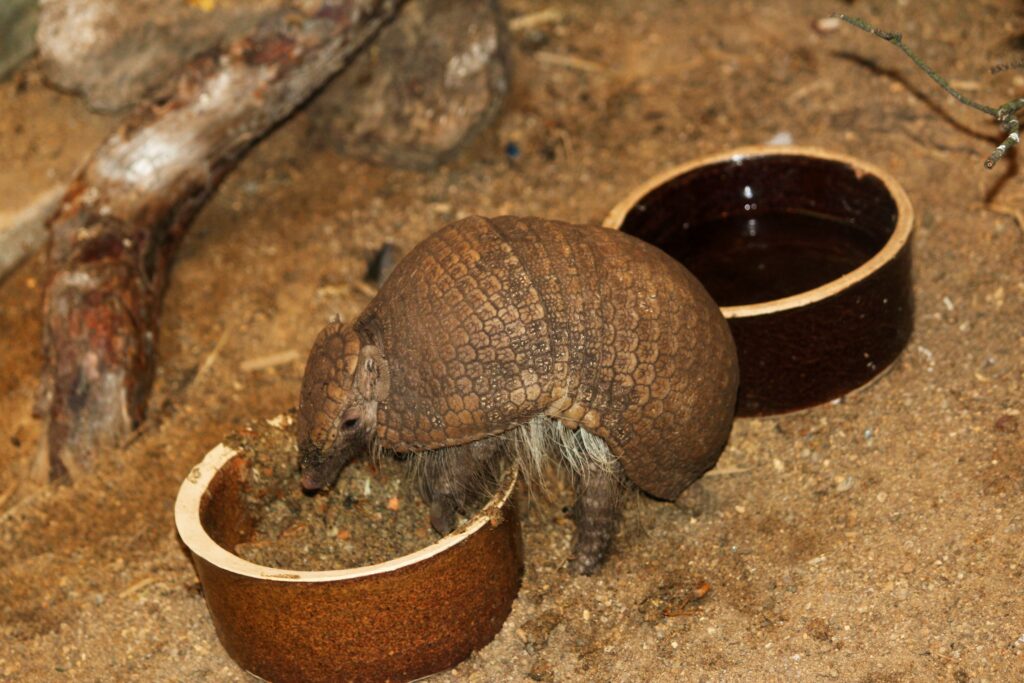
Armadillos are notorious for digging up lawns and gardens in search of insects and grubs. If you’re tired of dealing with these burrowing pests, read on for tips and tricks to send them packing.
Table of Contents
Identifying Armadillos
Armadillos are small, armored mammals with a distinctive leathery shell. They have long snouts, small eyes, and strong legs equipped with sharp claws for digging. Armadillos are nocturnal creatures, meaning they are most active during the night.
Top Tips for Dealing with Armadillos
- Remove their food source: Armadillos are attracted to areas with an abundance of insects, grubs, and other invertebrates. By reducing their food source, you can discourage them from invading your property. For example, you can use natural pest control methods to get rid of frogs and toads, eliminate ants, or deal with mouse droppings.
- Install fencing: Erecting a fence around your garden or yard can help keep armadillos out. Make sure the fence extends at least 18 inches underground to prevent them from burrowing beneath it.
- Use repellents: Commercial or homemade repellents, such as castor oil mixed with water, can be sprayed around your property to deter armadillos. Reapply the repellent after heavy rain or as needed.
- Live trapping: If armadillos continue to be a problem, you can use live traps to catch them. Bait the trap with worms or grubs and place it near their burrow. Once captured, relocate the armadillo at least five miles away from your property.
- Seek professional help: If all else fails, consider hiring a professional wildlife removal expert to handle the armadillo problem for you.
| Useful Amazon Products |
In-Depth Armadillo Control Strategies
Effective armadillo control requires a combination of preventative measures and removal techniques. In this section, we’ll explore some additional strategies to help you manage armadillos on your property.
Habitat Modification
Armadillos prefer habitats that provide cover, food, and easy burrowing opportunities. By making your property less attractive to armadillos, you can prevent them from moving in.
- Trim overgrown vegetation: Keep your lawn, bushes, and hedges well-trimmed. This reduces hiding spots and makes it harder for armadillos to burrow.
- Limit access to water sources: Armadillos need water to survive, so eliminating standing water or restricting access to ponds and streams can make your property less appealing.
- Address soil issues: Armadillos are attracted to loose, moist soil that’s easy to dig through. Compacting soil and ensuring proper drainage can make your property less desirable for burrowing.
Humane Harassment
Another approach to armadillo control is humane harassment, which involves making the armadillo’s environment uncomfortable so they’ll leave on their own.
- Motion-activated sprinklers: Installing motion-activated sprinklers can startle and deter armadillos from entering your property.
- Lights and noise: Set up bright lights and play loud noises near armadillo burrows at night. This can make the environment less comfortable for them and encourage them to leave.
Biological Control
Introducing natural predators or biological control agents can help reduce armadillo populations.
- Encourage predators: Animals such as owls, hawks, and snakes can prey on armadillos. By creating a welcoming environment for these predators, you can help control the armadillo population.
- Nematodes: Some species of nematodes can be used to control grubs and insects in your soil, which are primary food sources for armadillos. By reducing their food supply, you can make your property less attractive to armadillos.
Community Cooperation
Armadillo control is more effective when neighboring properties work together. Encourage your neighbors to join your efforts by:
- Sharing information about armadillo control strategies
- Collaborating on habitat modification projects
- Coordinating the use of repellents and other deterrents
By implementing a combination of these armadillo control strategies, you can protect your property and reduce the chances of armadillo infestations. Remember, patience and persistence are key when dealing with these persistent creatures.

How to Trap an Armadillo: A Detailed Guide
Trapping armadillos is a humane and effective way to remove them from your property. Follow these steps to successfully trap an armadillo:
Step 1: Choose the Right Trap
Select a sturdy, live trap designed for medium-sized animals. Ensure it is large enough to hold an armadillo comfortably, typically around 12″ x 12″ x 32″. Look for traps with sensitive triggers to ensure that the trap will close once the armadillo enters.
Step 2: Locate Active Burrows
Before setting the trap, identify active armadillo burrows on your property. Look for signs of fresh digging and disturbed soil. Armadillos are nocturnal, so they are more likely to be active during the night.
Step 3: Select the Best Trap Placement
Place the trap near active burrows, preferably along the armadillo’s travel path. This could be near fences, walls, or other structures that the armadillo may use as a guide. You may also set the trap directly in front of the burrow entrance.
Step 4: Prepare the Trap
Set the trap according to the manufacturer’s instructions. Make sure the trigger mechanism is working properly and that the trap door will close securely. Be cautious while handling the trap to avoid injuring yourself or the armadillo.
Step 5: Use Bait (Optional)
Armadillos are primarily attracted by the smell of the insects and grubs they feed on, so using bait is not always necessary. However, if you choose to use bait, opt for overripe fruits or a small amount of mealworms to attract the armadillo’s attention.
Step 6: Monitor the Trap
Check the trap at least once every 24 hours to see if you have caught an armadillo. Be prepared to release the armadillo promptly, as leaving it in the trap for extended periods can cause unnecessary stress or harm.
Step 7: Release the Armadillo
Once you have caught an armadillo, transport it to a suitable release site at least five miles away from your property, ideally in a wooded or natural area. Ensure that the release site is not near someone else’s property, and check local regulations regarding the release of trapped wildlife.
When releasing the armadillo, wear gloves and stand behind the trap to avoid any potential injury from the frightened animal. Open the trap door and allow the armadillo to exit on its own.
Step 8: Prevent Future Infestations
After successfully trapping and relocating the armadillo, take steps to prevent future infestations by modifying your property, using repellents, and eliminating food sources.
Remember that trapping should be done responsibly and in accordance with local laws and regulations. If you are unsure about the process or need assistance, consider hiring a professional wildlife removal service.
(Video)
FAQ
What draws armadillos to your yard?
Armadillos are attracted to yards with abundant food sources, such as insects, grubs, and worms. They also prefer loose, moist soil for digging and burrowing. Overgrown vegetation, woodpiles, and standing water can also provide suitable shelter and attract armadillos to your property.
What does armadillo yard damage look like?
Armadillo yard damage typically appears as small, shallow holes or patches of upturned soil. These holes are usually 1-3 inches wide and 1-2 inches deep. Armadillos dig in search of insects and grubs, which can lead to damaged lawns, gardens, and flower beds.
Should I fill an armadillo hole?
Yes, filling armadillo holes can help prevent injuries to people or pets and minimize further damage to your property. You can fill the holes with soil or a mixture of soil and grass seed to help your lawn recover. Be aware that filling the holes will not necessarily deter armadillos from returning, so it’s essential to implement preventative measures as well.
How do I get rid of armadillos in my yard naturally?
Armadillos, like all creatures, play a role in their ecosystem. They help control insect and grub populations by consuming large quantities of these pests. Additionally, their burrowing activities can help aerate soil and promote nutrient mixing. However, these benefits may not outweigh the damage they can cause to your property, so it’s essential to take steps to control armadillo populations and prevent damage to your yard.
Is there a natural predator for armadillos?
Natural predators of armadillos include coyotes, bobcats, foxes, large birds of prey (such as hawks and owls), and some larger snakes. However, armadillos have few predators due to their tough, armored shell, which provides protection against many threats.
Will lights keep armadillos away?
Lights can help deter armadillos, as they are nocturnal animals and prefer to forage in the dark. Installing bright, motion-activated lights near active armadillo burrows or areas of frequent activity can make the environment less comfortable for them and encourage them to leave.
Additional Resources for Pest Control
Check out these other helpful articles for dealing with common pests:
- How to Get Rid of Squirrels
- Effective Ways to Get Rid of Water Bugs
- Groundhog Diets, Habits, and Tips to Keep Them Away
- How to Get Rid of Pesky Chipmunks
- Getting Rid of Carpet Beetles
- Raccoon Removal Tips
- How to Get Rid of Pill Bugs and Rolly Pollies
- Chigger Identification and Removal
- Natural Ways to Get Rid of Maggots
- How to Get Rid of Squash Bugs
- Identifying and Eliminating Bed Bugs
- How to Get Rid of Bees Without Harming Them
- Identifying Roaches and Spotting Infestations
In conclusion, armadillos can be a nuisance, but with the right strategies, you can effectively keep them off your property. By eliminating their food sources, installing fences, using repellents, trapping them humanely, and seeking professional help if needed, you can protect your yard and garden from these burrowing pests. Be sure to check out the additional resources listed above for more helpful tips on dealing with other common pests.


